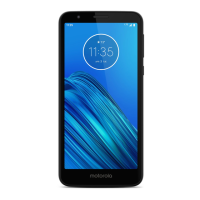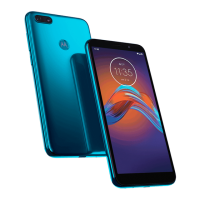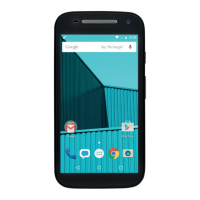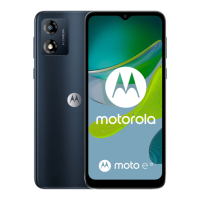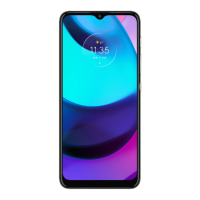Do you have a question about the Motorola Moto e6s and is the answer not in the manual?
Understand the physical components and layout of your phone. Includes hardware diagram.
Instructions for safely inserting and removing SIM and SD cards from your phone.
Guidance on transferring data from an iPhone or Android phone to your new device.
Learn how to set up and manage dual SIM profiles for your phone.
Steps to set up your voicemail password and greeting, and manage options.
Instructions for setting up personal and corporate email accounts on your phone.
Set up and view emergency information and send your location to emergency services.
Personalize your phone by setting wallpaper, adding apps, and adjusting screen settings.
An overview of the home screen layout, icons, widgets, and navigation elements.
Learn how to interact with your phone from the lock screen for quick access.
Guidance for users transitioning from iPhone, covering basic concepts and features.
Understand touch, drag, swipe, and pinch gestures for navigating your phone.
Access frequently used settings quickly from any screen for convenient adjustments.
Instructions on how to turn your phone's screen off and on manually or automatically.
Learn how to activate or deactivate the phone's flashlight using quick settings or gestures.
Use voice commands to perform tasks like making calls, getting directions, or setting alarms.
Utilize voice commands or widgets to get navigation and directions to destinations.
Add a widget to your home screen for quick access to alarms, calendar, and weather.
Utilize Digital Wellbeing features to understand and manage your phone usage habits.
Learn to open, close, resize the keyboard, and type special characters.
Select and manipulate text from web pages and messages efficiently.
Convert spoken words into text for faster and hands-free input.
Save and autofill personal information, addresses, and credit cards securely.
Customize your home screen by changing wallpaper, app shortcuts, widgets, and folders.
Add widgets for quick info, create app shortcuts, and organize apps into folders.
Explore and install third-party launchers to completely change your phone's look and feel.
Understand the physical components and layout of your phone. Includes hardware diagram.
Instructions for safely inserting and removing SIM and SD cards from your phone.
Guidance on transferring data from an iPhone or Android phone to your new device.
Learn how to set up and manage dual SIM profiles for your phone.
Steps to set up your voicemail password and greeting, and manage options.
Instructions for setting up personal and corporate email accounts on your phone.
Set up and view emergency information and send your location to emergency services.
Personalize your phone by setting wallpaper, adding apps, and adjusting screen settings.
An overview of the home screen layout, icons, widgets, and navigation elements.
Learn how to interact with your phone from the lock screen for quick access.
Guidance for users transitioning from iPhone, covering basic concepts and features.
Understand touch, drag, swipe, and pinch gestures for navigating your phone.
Access frequently used settings quickly from any screen for convenient adjustments.
Instructions on how to turn your phone's screen off and on manually or automatically.
Learn how to activate or deactivate the phone's flashlight using quick settings or gestures.
Use voice commands to perform tasks like making calls, getting directions, or setting alarms.
Utilize voice commands or widgets to get navigation and directions to destinations.
Add a widget to your home screen for quick access to alarms, calendar, and weather.
Utilize Digital Wellbeing features to understand and manage your phone usage habits.
Learn to open, close, resize the keyboard, and type special characters.
Select and manipulate text from web pages and messages efficiently.
Convert spoken words into text for faster and hands-free input.
Save and autofill personal information, addresses, and credit cards securely.
Customize your home screen by changing wallpaper, app shortcuts, widgets, and folders.
Add widgets for quick info, create app shortcuts, and organize apps into folders.
Explore and install third-party launchers to completely change your phone's look and feel.
| Form factor | Bar |
|---|---|
| Product color | Blue |
| Panel type | TFT-LCD |
| Pixel density | 282 ppi |
| Display diagonal | 6.1 \ |
| Display resolution | 1560 x 720 pixels |
| Native aspect ratio | 19.5:9 |
| High Dynamic Range (HDR) supported | Yes |
| Processor cores | 8 |
| Processor family | MediaTek |
| Processor frequency | 2 GHz |
| Processor architecture | ARM Cortex-A53 |
| Refurbished | - |
| Rear camera type | Dual camera |
| Front camera type | Single camera |
| Front camera pixel size | 1.12 µm |
| Front camera aperture number | 2.2 |
| Rear camera resolution (numeric) | 13 MP |
| Front camera resolution (numeric) | 5 MP |
| RAM capacity | 2 GB |
| Compatible memory cards | MicroSD (TransFlash) |
| Maximum memory card size | 256 GB |
| Internal storage capacity | 32 GB |
| Platform | Android |
| App distribution platform | Google Play |
| Operating system installed | Android 9.0 |
| Battery capacity | 3000 mAh |
| USB version | 2.0 |
| USB connector type | Micro-USB |
| Headphone connectivity | 3.5 mm |
| 4G standard | LTE |
| 3G standards | WCDMA |
| SIM card type | NanoSIM |
| Wi-Fi standards | 802.11b, 802.11g, Wi-Fi 4 (802.11n) |
| Bluetooth version | 4.2 |
| Mobile network generation | 4G |
| Near Field Communication (NFC) | No |
| Cables included | USB |
| Depth | 8.5 mm |
|---|---|
| Width | 73 mm |
| Height | 155.6 mm |
| Weight | 160 g |
